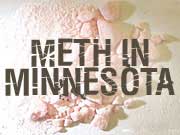|
Photos
More from MPR
Your Voice
|
Pawlenty issues plan to fight meth
October 25, 2004
 |
| This is crystal meth, also called "glass" or "ice." It's a more refined version of the drug that can sell for up to $200 a gram. Gov. Pawlenty announced a plan Monday to crack down on the proliferation of meth in Minnesota. (MPR file photo) |
St. Paul, Minn. — Gov. Tim Pawlenty promised Monday to wage more than a "Just Say No" campaign against methamphetamine, calling for stiffer penalties for makers of the drug and new steps to curb its production and use.
The Republican governor outlined his four-point plan before a national conference of legislators, law enforcement officials and other professionals who deal with the drug.
"Meth addiction is the steepest, slipperiest slope known to mankind and too many are falling off the edge based on ignorance," Pawlenty said. "People need to know this is not crystal meth, it is crystal death. And the death that it brings is slow, it is awful, it is painful, it is corrosive and it is destructive in so many ways."
Methamphetamine is a powerful stimulant that can be made in rudimentary labs out of common products including lye, lithium batteries and anhydrous ammonia, a common farm fertilizer. The process is dangerous and can leave toxic contamination.
|
Meth addiction is the steepest, slipperiest slope known to
mankind and too many are falling off the edge based on ignorance.
- Gov. Tim Pawlenty |
The plan Pawlenty expects to present to the Legislature next year seeks to:
-Prevent meth use by having schools and other community groups discuss its dangers and by limiting access to over-the-counter medicine often used to make the drug.
-Prosecute meth makers with the aid of 10 new state narcotics agents focused on meth only and enact increased penalties for producers. Having meth ingredients with the intent to make the drug would carry a 10-year prison term and an extra five years would be tacked on if children or vulnerable adults are present.
-Help local officials clean up sites used as meth labs by creating a state revolving loan fund. Users would be forced to pay restitution and no buildings or cars used as meth labs could be resold until cleanup is complete.
-Develop new treatment protocols to deal with meth users, including those in prison and on probation.
Pawlenty said his proposal would cost $3.5 million over the next two years plus an untold amount in added prison costs.
Little in Pawlenty's package is original. Many parts have been debated in the Legislature before. What's new is the priority Pawlenty said he will place on the issue in the upcoming session.
Sen. Julie Rosen, R-Fairmont, has sponsored past meth bills and hopes the governor's advocacy pays off.
"It's not just a rural problem anymore," she said. "It's in every corner in the state. It's not just a blue-collar problem anymore."
There were 301 labs seized in Minnesota in 2003, about 75 percent of which were in rural or semi-rural areas, according to the state Department of Public Safety.
Pawlenty made repeated mention to an Oklahoma law that restricts the sale of so-called precursor ingredients - like Sudafed and other medicine containing ephedrine and pseudoephedrine - by putting them behind store counters. He hasn't fully endorsed that idea, but he is considering it.
Buzz Anderson, president of the Minnesota Retailers Association, said his group wants to work with Pawlenty but notes that such restrictions can be problematic. Anderson said thousands of products contain the pseudoephedrine but only about 10 or 11 products are favored by meth cooks.
The drug often leads to violent and paranoid behavior, so the retailers group also worries about putting store clerks in danger if they refuse sales to meth producers.
"We've never been opposed to restricting some of the precursors," he said. "It's just a matter of how do you restrict them and which do you restrict."
(Copyright 2004 by The Associated Press. All Rights Reserved.)
|
News Headlines
|
Related Subjects
|

